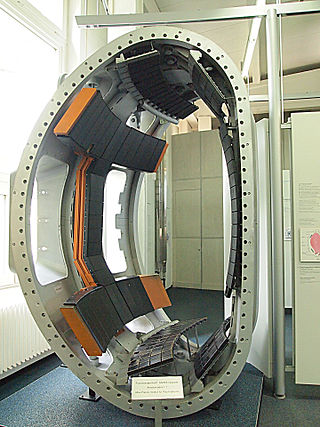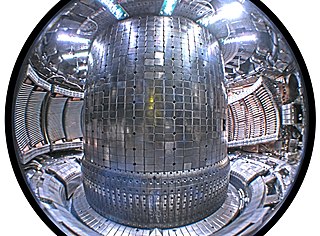Related Research Articles

Deuterium is one of two stable isotopes of hydrogen. The nucleus of a deuterium atom, called a deuteron, contains one proton and one neutron, whereas the far more common protium has no neutrons in the nucleus. Deuterium has a natural abundance in Earth's oceans of about one atom of deuterium among every 6,420 atoms of hydrogen. Thus deuterium accounts for approximately 0.0156% by number of all the naturally occurring hydrogen in the oceans, while protium accounts for more than 99.98%. The abundance of deuterium changes slightly from one kind of natural water to another.

Nuclear fusion is a reaction in which two or more atomic nuclei, usually deuterium and tritium, combine to form one or more different atomic nuclei and subatomic particles. The difference in mass between the reactants and products is manifested as either the release or absorption of energy. This difference in mass arises due to the difference in nuclear binding energy between the atomic nuclei before and after the reaction. Nuclear fusion is the process that powers active or main-sequence stars and other high-magnitude stars, where large amounts of energy are released.
Bubble fusion is the non-technical name for a nuclear fusion reaction hypothesized to occur inside extraordinarily large collapsing gas bubbles created in a liquid during acoustic cavitation. The more technical name is sonofusion.

A fusor is a device that uses an electric field to heat ions to a temperature in which they undergo nuclear fusion. The machine induces a voltage between two metal cages, inside a vacuum. Positive ions fall down this voltage drop, building up speed. If they collide in the center, they can fuse. This is one kind of an inertial electrostatic confinement device – a branch of fusion research.

Fusion power is a proposed form of power generation that would generate electricity by using heat from nuclear fusion reactions. In a fusion process, two lighter atomic nuclei combine to form a heavier nucleus, while releasing energy. Devices designed to harness this energy are known as fusion reactors. Research into fusion reactors began in the 1940s, but as of 2023, no device has reached net power.

Pyroelectricity is a property of certain crystals which are naturally electrically polarized and as a result contain large electric fields. Pyroelectricity can be described as the ability of certain materials to generate a temporary voltage when they are heated or cooled. The change in temperature modifies the positions of the atoms slightly within the crystal structure, so that the polarization of the material changes. This polarization change gives rise to a voltage across the crystal. If the temperature stays constant at its new value, the pyroelectric voltage gradually disappears due to leakage current. The leakage can be due to electrons moving through the crystal, ions moving through the air, or current leaking through a voltmeter attached across the crystal.

A neutron source is any device that emits neutrons, irrespective of the mechanism used to produce the neutrons. Neutron sources are used in physics, engineering, medicine, nuclear weapons, petroleum exploration, biology, chemistry, and nuclear power.
Muon-catalyzed fusion is a process allowing nuclear fusion to take place at temperatures significantly lower than the temperatures required for thermonuclear fusion, even at room temperature or lower. It is one of the few known ways of catalyzing nuclear fusion reactions.

Inertial electrostatic confinement, or IEC, is a class of fusion power devices that use electric fields to confine the plasma rather than the more common approach using magnetic fields found in magnetic confinement fusion (MCF) designs. Most IEC devices directly accelerate their fuel to fusion conditions, thereby avoiding energy losses seen during the longer heating stages of MCF devices. In theory, this makes them more suitable for using alternative aneutronic fusion fuels, which offer a number of major practical benefits and makes IEC devices one of the more widely studied approaches to fusion.

Neutron generators are neutron source devices which contain compact linear particle accelerators and that produce neutrons by fusing isotopes of hydrogen together. The fusion reactions take place in these devices by accelerating either deuterium, tritium, or a mixture of these two isotopes into a metal hydride target which also contains deuterium, tritium or a mixture of these isotopes. Fusion of deuterium atoms results in the formation of a helium-3 ion and a neutron with a kinetic energy of approximately 2.5 MeV. Fusion of a deuterium and a tritium atom results in the formation of a helium-4 ion and a neutron with a kinetic energy of approximately 14.1 MeV. Neutron generators have applications in medicine, security, and materials analysis.

Aneutronic fusion is any form of fusion power in which very little of the energy released is carried by neutrons. While the lowest-threshold nuclear fusion reactions release up to 80% of their energy in the form of neutrons, aneutronic reactions release energy in the form of charged particles, typically protons or alpha particles. Successful aneutronic fusion would greatly reduce problems associated with neutron radiation such as damaging ionizing radiation, neutron activation, reactor maintenance, and requirements for biological shielding, remote handling and safety.

Lithium tantalate (LiTaO3) is a perovskite which possesses unique optical, piezoelectric and pyroelectric properties which make it valuable for nonlinear optics, passive infrared sensors such as motion detectors, terahertz generation and detection, surface acoustic wave applications, cell phones and possibly pyroelectric nuclear fusion. Considerable information is available from commercial sources about this salt.
A dense plasma focus (DPF) is a type of plasma generating system originally developed as a fusion power device starting in the early 1960s. The system demonstrated scaling laws that suggested it would not be useful in the commercial power role, and since the 1980s it has been used primarily as a fusion teaching system, and as a source of neutrons and X-rays.

ASDEX Upgrade is a divertor tokamak at the Max-Planck-Institut für Plasmaphysik, Garching that went into operation in 1991. At present, it is Germany's second largest fusion experiment after stellarator Wendelstein 7-X.

Magnetized liner inertial fusion (MagLIF) is an emerging method of producing controlled nuclear fusion. It is part of the broad category of inertial fusion energy (IFE) systems, which drives the inward movement of fusion fuel, thereby compressing it to reach densities and temperatures where fusion reactions occur. Previous IFE experiments used laser drivers to reach these conditions, whereas MagLIF uses a combination of lasers for heating and Z-pinch for compression. A variety of theoretical considerations suggest such a system will reach the required conditions for fusion with a machine of significantly less complexity than the pure-laser approach. There are currently at least two facilities testing feasibility of the MagLIF concept, the Z-machine at Sandia Labs in the US and Primary Test Stand (PTS) located in Mianyang, China.

In nuclear fusion power research, the plasma-facing material (PFM) is any material used to construct the plasma-facing components (PFC), those components exposed to the plasma within which nuclear fusion occurs, and particularly the material used for the lining the first wall or divertor region of the reactor vessel.
Helion Energy, Inc. is an American fusion research company, located in Everett, Washington. They are developing a magneto-inertial fusion technology to produce helium-3 and fusion power via aneutronic fusion, which could produce low-cost clean electric energy using a fuel that is derived exclusively from water.
Ion Reactor, is an invention by a British scientist.
Lattice confinement fusion (LCF) is a type of nuclear fusion in which deuteron-saturated metals are exposed to gamma radiation or ion beams, such as in an IEC fusor, avoiding the confined high-temperature gasses used in other methods of fusion.
Seth J. Putterman is an American physicist. He is known to have an eclectic approach to research topics that broadly revolves around energy-focusing phenomena in nonlinear, continuous systems, with particular interest in turbulence, sonoluminescence, sonofusion and pyrofusion.
References
- ↑ "Supplementary methods for "Observation of nuclear fusion driven by a pyroelectric crystal"" (PDF).
- ↑ "UCLA Crystal Fusion". rodan.physics.ucla.edu.
- ↑ "Physics News Update 729". Archived from the original on November 12, 2013.
- ↑ Coming in out of the cold: nuclear fusion, for real | csmonitor.com
- ↑ "Nuclear fusion on the desktop ... really!". NBC News.
- ↑ Sidney Lang, "Pyroelectricity: From Ancient Curiosity to Modern Imaging Tool", Physics Today, August, 2005, pp. 31-36, and Sidney B. Lang, "Sourcebook of Pyroelectricity", (London: Gordon & Breach, 1974)
- 1 2 3 Dougar Jabon, V.D.; Fedorovich, G.V.; Samsonenko, N.V. (1997). "Catalitically Induced D-D Fusion in Ferroelectrics". Brazilian Journal of Physics. 27 (4): 515–521. Bibcode:1997BrJPh..27..515D. doi: 10.1590/s0103-97331997000400014 .
- ↑ B. Naranjo and S. Putterman "Search for fusion from energy focusing phenomena in ferroelectric crystals" Archived 2006-05-13 at the Wayback Machine . UCEI Proposal, February 1, 2002
- ↑ James D. Brownridge and Stephen M. Shafroth, Archived 2006-09-03 at the Wayback Machine , 1 May 2004
- ↑ Jeffrey A. Geuther, Yaron Danon, “Pyroelectric Electron Acceleration: Improvements and Future Applications”, ANS Winter Meeting Washington, D.C, November 14 – 18, 2004
- ↑ "Double Crystal Fusion" Could Pave the Way for Portable Device, News Releases, Rensselaer Polytechnic Institute: 2005-2006: "NY Team Confirms UCLA Tabletop Fusion" Archived 2006-03-19 at the Wayback Machine . www.scienceblog.com
- ↑ Tornow, W.; Lynam, S. M.; Shafroth, S. M. (2010). "Substantial increase in acceleration potential of pyroelectric crystals". Journal of Applied Physics. 107 (6): 063302–063302–4. Bibcode:2010JAP...107f3302T. doi:10.1063/1.3309841. hdl: 10161/3332 .
- ↑ :: James K. Gimzewski ::. Chem.ucla.edu. Retrieved on 2013-08-16.
- ↑ B. Naranjo, J. K. Gimzewski and S. Putterman (from UCLA), "Observation of nuclear fusion driven by a pyroelectric crystal". Nature , April 28, 2005. See also a news article on this. Archived 2008-09-15 at the Wayback Machine
- ↑ Brian Naranjo, "Observation of Nuclear Fusion Driven by a Pyroelectric Crystal", A dissertation submitted in partial satisfaction of the requirements for the degree Doctor of Philosophy in Physics, University of California, Los Angeles, 2006, 57 pages, Dr. Seth Putterman, Committee Chair. No reference to the earlier experimental work of Jabon, Fedorovich and Samsonenko [2] is found in Dr. Naranjo's dissertation.
- ↑ Geuther, Jeffrey A.; Danon, Yaron (2005). "Electron and positive ion acceleration with pyroelectric crystals". Journal of Applied Physics. 97 (7): 074109–074109–5. Bibcode:2005JAP....97g4109G. doi:10.1063/1.1884252.
- ↑ Jeffrey A. Geuther, "Radiation Generation with Pyroelectric Crystals", A Thesis submitted to the Graduate Faculty of Rensselaer Polytechnic Institute in Partial Fulfillment of the Requirements for the degree of Doctor of Philosophy in Nuclear Engineering and Science, Rensselaer Polytechnic Institute, Troy, New York, April 13, 2007, 176 pages, Dr. Yaron Danon, Thesis Adviser.
- ↑ Matin Durrani and Peter Rodgers "Fusion seen in table-top experiment" Archived 2005-04-29 at the Wayback Machine . Physics Web , April 27, 2005
- ↑ Taleyarkhan, R. P.; West, C. D.; Lahey, R. T.; Nigmatulin, R. I.; Block, R. C.; Xu, Y. (2006). "Nuclear Emissions During Self-Nucleated Acoustic Cavitation". Physical Review Letters. 96 (3): 034301. Bibcode:2006PhRvL..96c4301T. doi:10.1103/physrevlett.96.034301. PMID 16486709.
- ↑ Naranjo, B. (2006). "Comment on "Nuclear Emissions During Self-Nucleated Acoustic Cavitation"". Physical Review Letters. 97 (14): 149403. arXiv: physics/0603060 . Bibcode:2006PhRvL..97n9403N. doi:10.1103/physrevlett.97.149403. PMID 17155298. S2CID 31494419.
- ↑ Naranjo, B.; Putterman, S.; Venhaus, T. (2011). "Pyroelectric fusion using a tritiated target". Nuclear Instruments and Methods in Physics Research Section A: Accelerators, Spectrometers, Detectors and Associated Equipment. 632 (1): 43–46. Bibcode:2011NIMPA.632...43N. doi:10.1016/j.nima.2010.08.003.